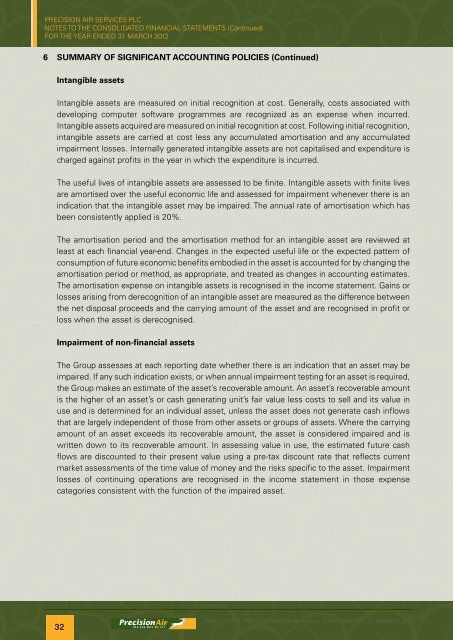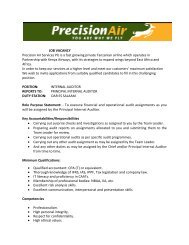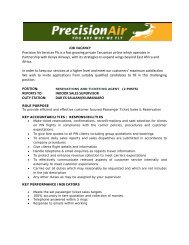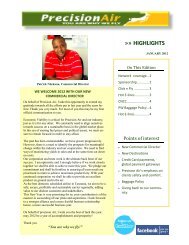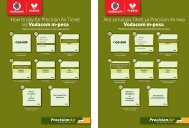Directors' Report and Financial Statements 31 March ... - Precision Air
Directors' Report and Financial Statements 31 March ... - Precision Air
Directors' Report and Financial Statements 31 March ... - Precision Air
Create successful ePaper yourself
Turn your PDF publications into a flip-book with our unique Google optimized e-Paper software.
PRECISION AIR SERVICES PLC<br />
NOTES TO THE CONSOLIDATED FINANCIAL STATEMENTS (Continued)<br />
FOR THE YEAR ENDED <strong>31</strong> MARCH 2012<br />
6 SUMMARY OF SIGNIFICANT ACCOUNTING POLICIES (Continued)<br />
Intangible assets<br />
Intangible assets are measured on initial recognition at cost. Generally, costs associated with<br />
developing computer software programmes are recognized as an expense when incurred.<br />
Intangible assets acquired are measured on initial recognition at cost. Following initial recognition,<br />
intangible assets are carried at cost less any accumulated amortisation <strong>and</strong> any accumulated<br />
impairment losses. Internally generated intangible assets are not capitalised <strong>and</strong> expenditure is<br />
charged against profits in the year in which the expenditure is incurred.<br />
The useful lives of intangible assets are assessed to be finite. Intangible assets with finite lives<br />
are amortised over the useful economic life <strong>and</strong> assessed for impairment whenever there is an<br />
indication that the intangible asset may be impaired. The annual rate of amortisation which has<br />
been consistently applied is 20%.<br />
The amortisation period <strong>and</strong> the amortisation method for an intangible asset are reviewed at<br />
least at each financial year-end. Changes in the expected useful life or the expected pattern of<br />
consumption of future economic benefits embodied in the asset is accounted for by changing the<br />
amortisation period or method, as appropriate, <strong>and</strong> treated as changes in accounting estimates.<br />
The amortisation expense on intangible assets is recognised in the income statement. Gains or<br />
losses arising from derecognition of an intangible asset are measured as the difference between<br />
the net disposal proceeds <strong>and</strong> the carrying amount of the asset <strong>and</strong> are recognised in profit or<br />
loss when the asset is derecognised.<br />
Impairment of non-financial assets<br />
The Group assesses at each reporting date whether there is an indication that an asset may be<br />
impaired. If any such indication exists, or when annual impairment testing for an asset is required,<br />
the Group makes an estimate of the asset’s recoverable amount. An asset’s recoverable amount<br />
is the higher of an asset’s or cash generating unit’s fair value less costs to sell <strong>and</strong> its value in<br />
use <strong>and</strong> is determined for an individual asset, unless the asset does not generate cash inflows<br />
that are largely independent of those from other assets or groups of assets. Where the carrying<br />
amount of an asset exceeds its recoverable amount, the asset is considered impaired <strong>and</strong> is<br />
written down to its recoverable amount. In assessing value in use, the estimated future cash<br />
flows are discounted to their present value using a pre-tax discount rate that reflects current<br />
market assessments of the time value of money <strong>and</strong> the risks specific to the asset. Impairment<br />
losses of continuing operations are recognised in the income statement in those expense<br />
categories consistent with the function of the impaired asset.<br />
32<br />
DIRECTORS’ REPORT AND FINANCIAL STATEMENTS <strong>31</strong> MARCH 2012


